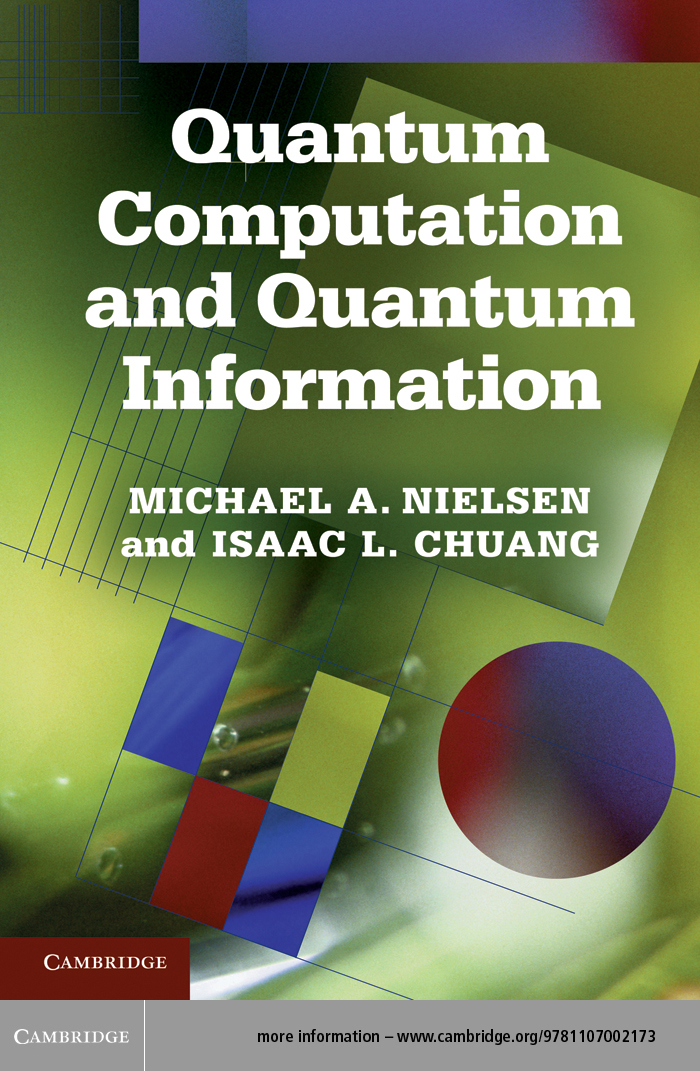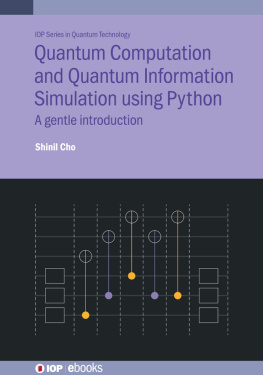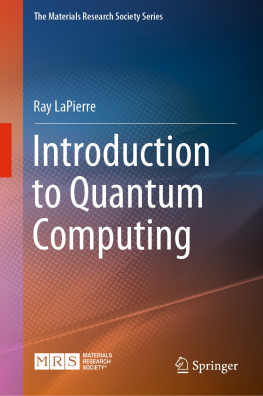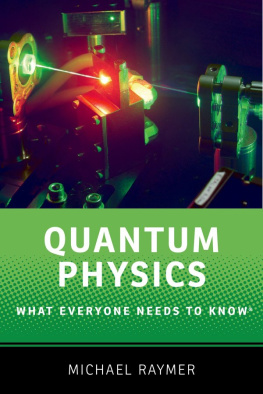Michael A. Nielsen - Quantum Computation and Quantum Information
Here you can read online Michael A. Nielsen - Quantum Computation and Quantum Information full text of the book (entire story) in english for free. Download pdf and epub, get meaning, cover and reviews about this ebook. publisher: Cambridge University Press, genre: Romance novel. Description of the work, (preface) as well as reviews are available. Best literature library LitArk.com created for fans of good reading and offers a wide selection of genres:
Romance novel
Science fiction
Adventure
Detective
Science
History
Home and family
Prose
Art
Politics
Computer
Non-fiction
Religion
Business
Children
Humor
Choose a favorite category and find really read worthwhile books. Enjoy immersion in the world of imagination, feel the emotions of the characters or learn something new for yourself, make an fascinating discovery.

- Book:Quantum Computation and Quantum Information
- Author:
- Publisher:Cambridge University Press
- Genre:
- Rating:5 / 5
- Favourites:Add to favourites
- Your mark:
- 100
- 1
- 2
- 3
- 4
- 5
Quantum Computation and Quantum Information: summary, description and annotation
We offer to read an annotation, description, summary or preface (depends on what the author of the book "Quantum Computation and Quantum Information" wrote himself). If you haven't found the necessary information about the book — write in the comments, we will try to find it.
Quantum Computation and Quantum Information — read online for free the complete book (whole text) full work
Below is the text of the book, divided by pages. System saving the place of the last page read, allows you to conveniently read the book "Quantum Computation and Quantum Information" online for free, without having to search again every time where you left off. Put a bookmark, and you can go to the page where you finished reading at any time.
Font size:
Interval:
Bookmark:

Quantum Computation and Quantum Information
10th Anniversary Edition
One of the most cited books in physics of all time, Quantum Computation and Quantum Information remains the best textbook in this exciting field of science. This 10th Anniversary Edition includes a new Introduction and Afterword from the authors setting the work in context.
This comprehensive textbook describes such remarkable effects as fast quantum algorithms, quantum teleportation, quantum cryptography, and quantum error-correction. Quantum mechanics and computer science are introduced, before moving on to describe what a quantum computer is, how it can be used to solve problems faster than classical computers, and its real-world implementation. It concludes with an in-depth treatment of quantum information.
Containing a wealth of figures and exercises, this well-known textbook is ideal for courses on the subject, and will interest beginning graduate students and researchers in physics, computer science, mathematics, and electrical engineering.
M ICHAEL N IELSEN was educated at the University of Queensland, and as a Fulbright Scholar at the University of New Mexico. He worked at Los Alamos National Laboratory, as the Richard Chace Tolman Fellow at Caltech, was Foundation Professor of Quantum Information Science and a Federation Fellow at the University of Queensland, and a Senior Faculty Member at the Perimeter Institute for Theoretical Physics. He left Perimeter Institute to write a book about open science and now lives in Toronto.
I SAAC C HUANG is a Professor at the Massachusetts Institute of Technology, jointly appointed in Electrical Engineering & Computer Science, and in Physics. He leads the quanta research group at the Center for Ultracold Atoms, in the MIT Research Laboratory of Electronics, which seeks to understand and create information technology and intelligence from the fundamental building blocks of physical systems, atoms, and molecules.
In praise of the book 10 years after publication
Ten years after its initial publication, Mike and Ike (as its affectionately called) remains the quantum computing textbook to which all others are compared. No other book in the field matches its scope: from experimental implementation to complexity classes, from the philosophical justifications for the Church-Turing Thesis to the nitty-gritty of bra/ket manipulation. A dog-eared copy sits on my desk; the section on trace distance and fidelity alone has been worth many times the price of the book to me.
Scott Aaronson, Massachusetts Institute of Technology
Quantum information processing has become a huge interdisciplinary field at the intersection of both, theoretical and experimental quantum physics, computer science, mathematics, quantum engineering and, more recently, even quantum metrology. The book by Michael Nielsen and Isaac Chuang was seminal in many ways: it paved the way for a broader, yet deep understanding of the underlying science, it introduced a common language now widely used by a growing community and it became the standard book in the field for a whole decade. In spite of the fast progress in the field, even after 10 years the book provides the basic introduction into the field for students and scholars alike and the 10th anniversary edition will remain a bestseller for a long time to come. The foundations of quantum computation and quantum information processing are excellently laid out in this book and it also provides an overview over some experimental techniques that have become the testing ground for quantum information processing during the last decade. In view of the rapid progress of the field the book will continue to be extremely valuable for all entering this highly interdisciplinary research area and it will always provide the reference for those who grew up with it. This is an excellent book, well written, highly commendable, and in fact imperative for everybody in the field.
Rainer Blatt, Universtitt Innsbruck
My well-perused copy of Nielsen and Chuang is, as always, close at hand as I write this. It appears that the material that Mike and Ike chose to cover, which was a lot, has turned out to be a large portion of what will become the eternal verities of this still-young field. When another researcher asks me to give her a clear explanation of some important point of quantum information science, I breathe a sigh of relief when I recall that it is in this book my job is easy, I just send her there.
David DiVincenzo, IBM T. J. Watson Research Center
If there is anything you want to know, or remind yourself, about quantum information science, then look no further than this comprehensive compendium by Ike and Mike. Whether you are an expert, a student or a casual reader, tap into this treasure chest of useful and well presented information.
Artur Ekert, Mathematical Institute, University of Oxford
Nearly every child who has read Harry Potter believes that if you just say the right thing or do the right thing, you can coerce matter to do something fantastic. But what adult would believe it? Until quantum computation and quantum information came along in the early 1990s, nearly none. The quantum computer is the Philosophers Stone of our century, and Nielsen and Chuang is our basic book of incantations. Ten years have passed since its publication, and it is as basic to the field as it ever was. Matter will do wonderful things if asked to, but we must first understand its language. No book written since (there was no before) does the job of teaching the language of quantum theorys possibilities like Nielsen and Chuangs.
Chris Fuchs, Perimeter Institute for Theoretical Physics
Nielsen and Chuang is the bible of the quantum information field. It appeared 10 years ago, yet even though the field has changed enormously in these 10 years - the book still covers most of the important concepts of the field.
Lov Grover, Bell Labs
Quantum Computation and Quantum Information, commonly referred to as Mike and Ike, continues to be a most valuable resource for background information on quantum information processing. As a mathematically-impaired experimentalist, I particularly appreciate the fact that armed with a modest background in quantum mechanics, it is possible to pick up at any point in the book and readily grasp the basic ideas being discussed. To me, it is still the book on the subject.
David Wineland, National Institute of Standards and Technology, Boulder, Colorado
Endorsements for the original publication
Chuang and Nielsen have produced the first comprehensive study of quantum computation. To develop a robust understanding of this subject one must integrate many ideas whose origins are variously within physics, computer science, or mathematics. Until this text, putting together the essential material, much less mastering it, has been a challenge. Our Universe has intrinsic capabilities and limitations on the processing of information. What these are will ultimately determine the course of technology and shape our efforts to find a fundamental physical theory. This book is an excellent way for any scientist or graduate student in any of the related fields to enter the discussion.
Michael Freedman, Fields Medalist, Microsoft
Nielsen and Chuangs new text is remarkably thorough and up-to-date, covering many aspects of this rapidly evolving field from a physics perspective, complementing the computer science perspective of Gruskas 1999 text. The authors have succeeded in producing a self-contained book accessible to anyone with a good undergraduate grounding in math, computer science or physical sciences. An independent student could spend an enjoyable year reading this book and emerge ready to tackle the current literature and do serious research. To streamline the exposition, footnotes have been gathered into short but lively History and Further Reading sections at the end of each chapter.
Font size:
Interval:
Bookmark:
Similar books «Quantum Computation and Quantum Information»
Look at similar books to Quantum Computation and Quantum Information. We have selected literature similar in name and meaning in the hope of providing readers with more options to find new, interesting, not yet read works.
Discussion, reviews of the book Quantum Computation and Quantum Information and just readers' own opinions. Leave your comments, write what you think about the work, its meaning or the main characters. Specify what exactly you liked and what you didn't like, and why you think so.




